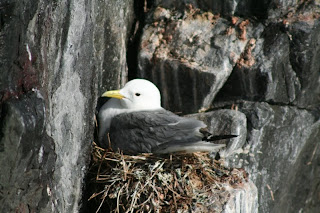 Saying hello, a yearling Grey Seal
Saying hello, a yearling Grey SealTuesday 30th June comments:
Hot, hot, hot…but not here. The British Isles is basking in a heat wave (or so I’ve been told) but hot sunny weather, with a light southerly wind brings only one thing to the islands: fog! The fog has been with us for four days and we’ve not seen the mainland for sometime. Even visitor boats were struggling yesterday as we couldn’t see the main jetty from the Pele Tower – visibility can only be described as poor!
However work doesn’t stop because of fog, this is a seabird colony and its still all go. The monitoring of seabirds has eased (just a little bit) as birds start leaving the islands whilst bird ringing and general research continues. The number of visitors continues to be high (despite the fog!) and generally spirits are high. The main reason is due to the great success of our seabirds, as we approach July and its looking like a great season…
The world of Farnes will become busy tomorrow as the press release will go ‘live’ and I suspect we’ll have a few enquiries during the course of the day, but we’ll have to wait see. Otherwise all is well and if everyone could share the sunshine with us out here, that would be great.
Highlights: Common Sandpiper on Staple Island (first of the autumn) and Purple Sandpiper 1.
Breeding birds: Good groups of Shag fledglings have started gathering in sheltered areas of the islands forming ‘family super groups’, one of the last nesting female Eiders has gone with very few remaining, Black-headed Gull a few more chicks fledgling from the colonies, Sandwich Tern chicks now fledgling as birds bring chicks down to the beach, Arctic Tern – the first fledged today, Common Tern chicks now medium sized, Guillemots and Razorbills continue to leave with huge gaps starting to appear on the cliffs and Puffins chicks leaving in the droves.
Butterflies: Painted Ladies are moving through the islands in good numbers with 70+ today, Painted Ladies several.
Cetaceans: nothing to report as we can’t see the sea due to the fog!
Hot, hot, hot…but not here. The British Isles is basking in a heat wave (or so I’ve been told) but hot sunny weather, with a light southerly wind brings only one thing to the islands: fog! The fog has been with us for four days and we’ve not seen the mainland for sometime. Even visitor boats were struggling yesterday as we couldn’t see the main jetty from the Pele Tower – visibility can only be described as poor!
However work doesn’t stop because of fog, this is a seabird colony and its still all go. The monitoring of seabirds has eased (just a little bit) as birds start leaving the islands whilst bird ringing and general research continues. The number of visitors continues to be high (despite the fog!) and generally spirits are high. The main reason is due to the great success of our seabirds, as we approach July and its looking like a great season…
The world of Farnes will become busy tomorrow as the press release will go ‘live’ and I suspect we’ll have a few enquiries during the course of the day, but we’ll have to wait see. Otherwise all is well and if everyone could share the sunshine with us out here, that would be great.
Highlights: Common Sandpiper on Staple Island (first of the autumn) and Purple Sandpiper 1.
Breeding birds: Good groups of Shag fledglings have started gathering in sheltered areas of the islands forming ‘family super groups’, one of the last nesting female Eiders has gone with very few remaining, Black-headed Gull a few more chicks fledgling from the colonies, Sandwich Tern chicks now fledgling as birds bring chicks down to the beach, Arctic Tern – the first fledged today, Common Tern chicks now medium sized, Guillemots and Razorbills continue to leave with huge gaps starting to appear on the cliffs and Puffins chicks leaving in the droves.
Butterflies: Painted Ladies are moving through the islands in good numbers with 70+ today, Painted Ladies several.
Cetaceans: nothing to report as we can’t see the sea due to the fog!

















































